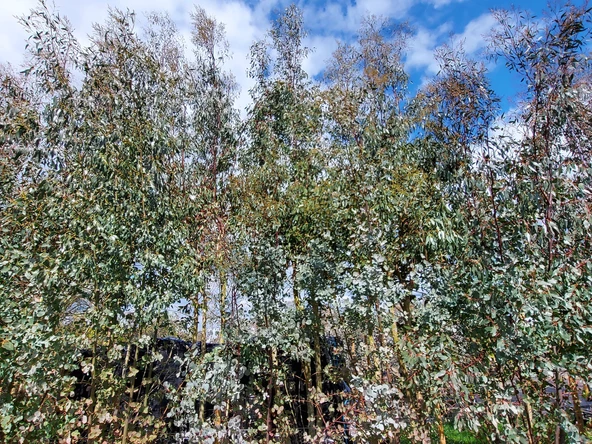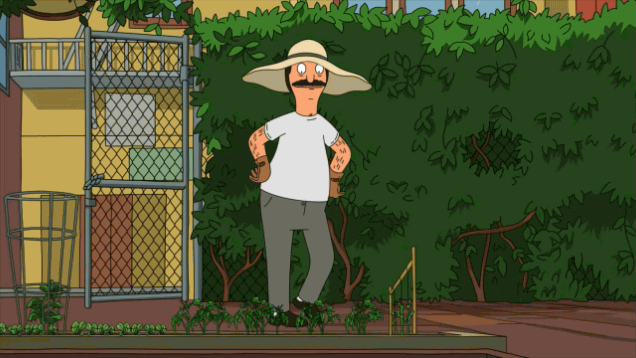
‘Our neighbours have installed a loft extension. The dormer windows overlook our garden! Overnight, we’ve lost our privacy. What evergreen screening can you supply?’
‘Developers have demolished the plum orchard at the end of our garden and begun work on a 10 acres housing estate. We now feel very overlooked and need quick growing trees for privacy!’
‘Our new neighbours have removed their ghastly leylandii hedge, but now they are looking from their house straight into our sitting room windows! Can you help us choose some quick growing Eucalyptus for screening at around 3m tall?’

Just three cries for help we received at Hardy Eucalyptus HQ during March this year. After a brief chat with each home owner, we’re pleased to say we were able to help all three with an evergreen tree solution to provide privacy screening. Well behaved small Eucalyptus, that can easily be managed with a little annual pruning.

Back in the day, Leyland cypress used to be the screening tree of choice. Fortunately, it is no longer popular. The gloomy conifer did nothing to benefit pollinating insects or nesting birds other than the odd pigeon. The more classic Yew (Taxus baccata) is great in formal settings but painfully slow to gain height and all plant parts are extremely poisonous. There are many other evergreens such as cherry laurel (Prunus laurocerasus) and Photinia ‘Red Robin’, Escallonia, Osmanthus etc. Some are faster growing than others. However, they all have one thing in common – they are not happy in wet soils. Enter the smaller Eucalyptus, some species of which are more than happy in soggy ground.
Above: A subtle, unobtrusive Leylandii screen. Beloved by the pigeons, and little else.
Of the 1,000+ species and varieties available worldwide, some 60+ are hardy enough to grow in the UK. Unfortunately, Eucalyptus gunnii is the most frequently sold species in UK retail emporia.

E. gunnii subsp. gunnii to use its full name, has sadly been mis-labelled and therefore wrongly installed in many unsuitable locations over many decades. Planted by unsuspecting gardeners, it then grows unchecked and unpruned, to enormous proportions in the rich soils of small back gardens. Like an unwanted guest – it has eaten too much and rather over-stayed its welcome! In short, E. gunnii has given its entire family a bad name.
Mis-labelled? E. gunnii will absolutely grow to the 5m as stated on ‘that emporium’s’ plant label (seriously, we’ve seen that twice this past month). Then it will carry on growing quite happily until it reaches 15-20m and possibly beyond. It’s a very water hungry species and thrives in wet clay soils. An ideal tree for the farmer to drain a swampy field, so sheep can graze all year round, but not-so-great for the gardener with a pocket handkerchief of a plot. If you have one, keep it pruned annually to a bushy shrub. Use it for floral art.
At Hardy Eucalyptus, we have researched extensively and specialise in over 23 smaller growing Eucalypts. Ones with nice table manners! Those that are naturally smaller growing and ones that are faster growing, but can be managed with some annual pruning. All are ideal for the smaller garden.

Each species has its own ‘personality’, if you will! Eucalyptus are very site specific in their requirements. Some thrive in wet conditions, whilst others are more-sniffy, requiring a free-draining garden soil. Some Eucalypts tolerate windy exposure, a few prefer a bit of shelter.
Armed with your site assessment, take a look at our Magnificent 7 Eucalyptus below and match their needs with your requirements.
Numbers 1-6 are all fast growing. Can be easily pruned to a shrub-on-a-stick lollipop, kept as a small tree or bushy shrub, or allowed to reach full height. Number 7 is more sedate and naturally smaller.
1. Omeo Gum – Eucalyptus neglecta ‘Dargo Plains’
Very easy to grow, unusually fast for a small Euc. Quickly reaches 2-3m in its first season if you plant a 5 litre young tree or you can buy a 3m+ tall specimen in a 12 or 20 litre pot. Unpruned, it can reach around 7m tall.
Jade green, round saucer-like juvenile leaves mature to bay-leaf-on-steroids adult foliage – brilliant for screening. New foliage is a gorgeous violet suffused with silver.
Good news – the Omeo gum will grow in full sun and part dappled shade/
Any soil, but is at its most-bushiest, when given plenty of moisture. Likes wet clays, tolerates limestone. Very hardy. Root hardy down to around -12 °C to -15 °C.
2. Alpine Cider Gum – Eucalyptus archeri
Smaller cousin of E. gunnii, topping out at only 10-12m if unpruned. Makes an excellent silvery-blue billowy hedge-screen, which is difficult to see through. Easy to prune. Classic round blue leaf matures to the falcate adult foliage. Flowers for a very long time – Spring into Summer. Likes full sun. Any normal garden soil including clay and limestone. Very hardy – sheltered or exposed locations. Root hardy down to around -15 °C.
3. Small Leaved Kybean Gum– Eucalyptus parvula
From Dragon Swamp. Excellent as a multi-stemmed bush or tree. 10m if grown without pruning, but can be kept at 2.4m to 5m with ease. Makes a good billowy screen – bit like pollarded willow. Lots of small neat leaves. Likes full sun. Good in moist and free-draining soils, tolerant of limestone. Extremely hardy down to -16 to -18°C. Suitable for exposed conditions.
4. Victorian Silver Gum – Eucalyptus crenulata
A really bushy, modest-growing tree or shrub for sun or part shade. Topping out at around 10-12m, but can be managed at 2.4m-5.0m. Neat palmate leaves which never seem to change shape. Fabulous sweetly scented flowers. Enjoys normal to moist garden soils, avoid limestone. Likes a bit of shelter, but root hardy to around -8 to –10°C.
5. Tasmanian Alpine Yellow Gum – Eucalyptus subcrenulata
One of my favourites. A fast grower, once established, it can exceed 15 meters, but then so can a Beech tree! Initially upright growth habit, but retains its lower foliage for a long time. E. subcrenulata makes an excellent bushy hedge. Our dense nursery screen is kept to 2.4m tall. Allowed to grow up to around 3m, it’s pruned every Spring.
Green foliage which sits comfortably in the landscape. Flowers autumn – loved by honey bees and Goldfinches nest in the top. We use a great deal for floristry.
Root hardy to around -14 to –16°C. Does best in full sun and normal to moist soils; avoid very dry soils.
6. French Blue Gum – Eucalyptus ‘France Bleu’
Amazing new cultivar, quite fast growing – reaching 3-4m tall. Can be kept as a smaller bushy shrub, great as a billowy hedge screen. Small strap-like juvenile foliage, lengthen slightly with maturity in a stunning silvery blue, with pink haze of new growth in summer. Any normal garden soil; tolerant of limestone. Full sun and a sheltered location. Root hardy to around -10 °C.
7. Kybean Mallee Ash – Eucalyptus kybeanensis
Really small Eucalyptus reaching around 4m with a fine tracery of foliage. Light open canopy producing a feathery screen. Flowers November through to April – loved by honey bees. Great replacement for the problematic olive tree. Very hardy, tolerates cold, exposed conditions. Thrives in free-draining soils and grows well at Hardy Eucalyptus in our swampy yellow clay. Root hardy down to -14°C to -16°C. Prune shoot tips to keep bushy.
Still unsure what to choose? Get in touch! Our team of horticulturists will help you select the right species of Eucalyptus to best fit your requirements and lifestyle.

Above: A dense eucalyptus screen, achieved by planting staggered rows of young trees from a mixture of species. Managed by periodically pollarding and coppicing.
Once your screening tree is selected, Hardy Eucalyptus will send you comprehensive planting and after-care notes, tailored towards helping your tree establish very quickly. This is so you can give your new Eucalyptus the best start in life in your garden. You will also be enrolled free of charge into our Gumnut Club, for as long as you want (tick the box at checkout or email us!). Once a month we’ll email you with comprehensive notes on caring for your tree, how to prune, what to feed and when.
Unless you are growing for cut foliage, the two pruning dates for your ornamental Eucalyptus are quite prescriptive. The first date is National Eucalyptus Day UK, which, as you know, is St Shelagh’s Day – 18th March. The second date is called the Chelsea Chop. Seriously, I’m not making this up!
A good structural prune around the Spring Equinox sets your Eucalyptus up nicely at the beginning of the year. The risk of snow is generally diminished, the temperature is rising and the days are lengthening. All this triggers Eucalyptus into growth.
Prune any damaged branches after winter and reduce the tree height, before the roots fire up in April, and begin pushing out the nutrient rich sap. This sap does not want to be wasted on growth you subsequently cut off. Strong buds low down in the tree will be encouraged to break and make your tree nice and bushy.
The Chelsea Chop occurs, you guessed it, the week after the Chelsea Flower Show, in May. This light trim needs to occur prior to the Summer Solstice. Eucalyptus really step-up their growing speed after the 25th of June and by August they go completely bonkers. Therefore, a light trim helps them consolidate the early spring growth and again, encourages bushiness.

Autumn and Winter pruning must be avoided at all costs.
If harvesting foliage for floral art at the back end of the year, there is an accepted risk that the cold weather could seriously damage your tree or even kill it. Pruning after the middle of August is a definite ‘no’ for ornamentals.
So if you need to block out a nosy neighbour or want to hide your light under a bushel, Hardy Eucalyptus have a suitable evergreen screening tree for you.
Give us a call on 07307 413 052, email us at [email protected], or visit www.hardy-eucalyptus.com
Tel: 01905 888 098
Monday-Friday, 9.00am-4.00pm
Grafton Nursery,
Worcestershire
(Visits by appointment)


We’re here to help you choose your Eucalyptus
We’ll also email you with expert seasonal advice for
your Eucalyptus & exclusive offers. No spam – just Eucalyptus.
You can opt out at any time. Click here to see our privacy policy in full.